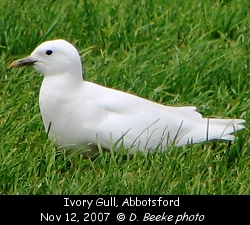The Ivory Gull
By Gord Gadsden
Dec 11, 2007
The recent discovery of an Ivory Gull in Abbotsford last  month and the resulting excitement at such an incredible find in our area made this species an easy choice to write about. month and the resulting excitement at such an incredible find in our area made this species an easy choice to write about.
Ivory Gulls are the only all white gulls. Juveniles are also white but with black speckles on their face, neck, wings and a black tail tip. Both adults and juveniles have black legs and eyes. They are a smaller gull, just a tad heavier than a Ring-billed Gull.
Ivory Gulls spend their entire lives in the Arctic being perfectly at home on pack ice and cold conditions. They are considered a Species at Risk due to their low numbers, recent alarming declines and sensitivity to being disturbed on their breeding grounds. Total population is estimated at about 35,000 individuals. Breeding numbers in the Canadian Arctic are estimated at 2,400 individuals. Ivory Gulls are not common outside their range but are observed in the East south to New York and inland to the Great Lakes. Sightings further west are very rare. Ivory Gulls feed on small creatures picked from the water's surface while in flight. They will also feed on carrion from creatures such as whales and walruses washed up on shore.
Ivory Gulls nest in colonies ranging from several to over 150 pairs. Their nesting locations vary dramatically from flat locations or cliff edges. Nests are built using moss, grass and lichens. One to three eggs are laid which are incubated by the male and female. Ivory Gulls are very sensitive to disturbance when on their breeding grounds and will abandon a nest if approached by predators, humans or aircraft.
While things are looking bleak with dramatic population declines (%80 in six years) and apparent mercury contamination efforts are under way to help this species recover.
Links and sources:
Species at Risk - http://www.speciesatrisk.gc.ca/search/speciesDetails_e.cfm?SpeciesID=50
Ehrlich, Dobkin and Wheye, (1988)
Sibley, D. (2000) |